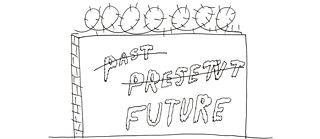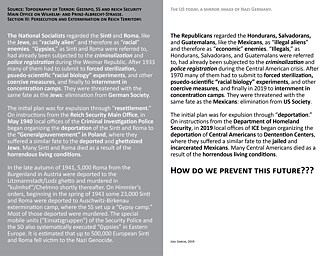Comparing narratives
Monumental Violence, from Germany to the United States

Joel Garcia reflects on his time in Berlin, especially around the ways the formerly divided city offered a site to engage borders and monumentality in the U.S., and considers narratives of freedom and manifestations of white supremacy.
By Joel Garcia
As an Indigenous person of Huichol ancestry, whose family has been impacted by hateful legislation such as the Mexican Repatriation Act (mass deportation of Native Americans, Mexicans and Mexican-Americans from the United States between 1929 and 1936) disguised as economic relief strategies, this reflection is a moment for me to pause and analyze two trajectories: the pre-holocaust time in Germany and what is occurring now in the US. From just a limited sampling of my visit to Berlin accompanied by lifelong extensive research on, experience with, and analysis of white supremacy, I encourage folks reading this post to understand this reflection from the perspective of an Indigenous person living in Southern California.
Although California is looked at as a progressive state, in actuality it's a place where racism is deeply rooted in its foundation, stemming from the Mission project and the Gold Rush, both of which aimed at ethnically cleansing this region.
What struck me about the build up to the Holocaust was the carefully constructed narratives developed to dehumanize people in very much the same way the media and politicians use language to pacify hate. Just last summer, El Paso suffered from a shooting spree killing 20 people. These people were murdered by a white male 21-year old who left a “manifesto” and yet the media dug deep into its thesaurus to produce the use of the word “screed” to avoid using the word manifesto, and thereby linking his activity to an act of hate, or rather to avoid confirming it was an act of hate.
California used creative language within its laws to legally commit acts of genocide and displace Indigenous Peoples. California isn't the only place that did this and if you fast forward to Arizona in the early 2000’s, that state served as a testing ground for this type of legislation through SB1070 and other laws that never made it past a proposal. The strategy with this racist think tank was to come up with the most outrageous language, in order to test what the public would tolerate. Kris Kobach, SB1070’s author joined Trump’s team early on.
This form of slow-cooking and incrementally increasing both legal and public forms of violence is exactly what took place in Germany. On one hand you have the very public displays of violence by police and individuals which creates a specific response for more “safety” through legislation. And when we are driven by fear and given an ethnic group as a scapegoat, the public will usually relinquish “freedom.” This is exactly how the Department of Homeland Security was created. We all remember President Bush (the son) but we quickly forget the men behind him pulling the strings such as Vice President Cheney and Secretary of Defense Rumsfeld, men with career-long ambitions and connected to industries fueled by blood such as Halliburton.
In Germany, individuals like Heinrich Himmler, who are crafty enough to know that being in the spotlight restricts their true intentions, know that the influence behind the scenes is much more powerful. Himmler was able to amass control of the state police, then the national police, and ultimately Poland and other occupied territories.
In the US, as much as we want Trump to be the sole conspirator and person responsible behind the resurgence of hate in this country, we must look deeper into the shadows to recognize the faces and systems in our own neighborhoods that validate his antics, accept the rhetoric, and ultimately uphold white supremacy by pacifying it through how we speak about things or fail to speak about white supremacy.
